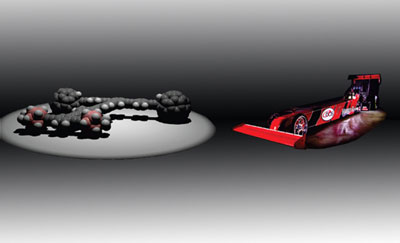| Posted: January 6, 2010 |
Nanotechnology dragster races toward the future of molecular machines |
|
(Nanowerk News) Scientists in Texas are reporting the development of a “nanodragster” that may speed the course toward development of a new generation of futuristic molecular machines. The vehicle — only 1/50,000th the width of a human hair — resembles a hot-rod in shape and can outperform previous nano-sized vehicles. Their report is in ACS’ Organic Letters ("Molecular Machinery: Synthesis of a “Nanodragster”").
|
 |
| New “nanodragster” (left) may lead to molecular machines for manufacturing computer circuits and other electronic components.
|
|
James Tour, Kevin Kelly and colleagues note that the ability to control the motion of small molecules is essential for building much-anticipated molecular machines. Some of these machines may find use in manufacturing computer circuits and other electronic components in the future. Scientists have already made strides by designing nano-sized vehicles, including a “nanocar” with wheels made of buckyballs — spheres of carbon containing 60 atoms apiece. The car can scoot around a gold surface when exposed to heat or an electric field gradient. But control of its movement is limited. These drawbacks prevent its widespread use. But the most limiting factor is the nanoscopic resolution tools available for studying their range of motions and capabilities.
|
|
The new vehicle addresses some of these problems. The front end has a smaller axle and wheels made of special materials that roll easier. The rear wheels sport a longer axle but are still made of buckyballs, which provide strong surface grip. These changes result in a “nanodragster” that can operate at lower temperatures than a regular nanocar and possibly has has better agility, paving the way for better molecular machines, the scientists say.
|

